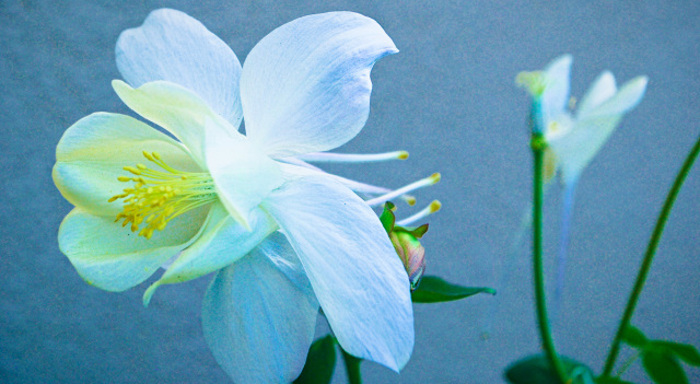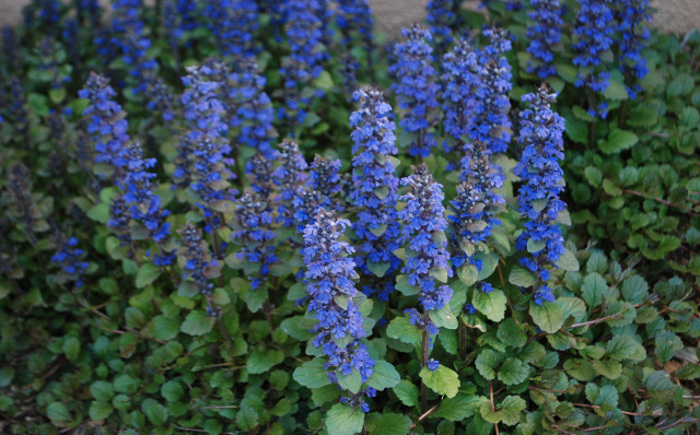Usually, sun and heat are more trouble in the Southwest than shade. But sometimes, you want to plant flowers or vines under a tree or have a shady spot near the house that needs plants!
Plenty of plants that tolerate low light and low water work well on covered patios, north-facing walls or under trees. Here are a few choices that grow well in in the shade but don't require a lot of water.

Columbine blooms are so delicate and interesting. It’s a favorite!
Columbine (Aquilegia)
This plant is a stunning native. The Rocky Mountain columbine is state flower or Colorado, and that’s fitting since it grows naturally in the stippled shade of trees at high altitudes (6,000 to 10,000 feet). The Rocky Mountain columbine has a two-toned flower with bluish purple outer petals and white petals in the center. Planting columbine under a tree usually works well in high deserts and intermountain areas of the West unless the soil drains poorly.
The best part? It’s perennial, and should come back every year; it also will re-seed nearby. There are plenty of colors and varieties of monotone and two-toned columbine. The plant can get powdery mildew when it’s especially rainy with warm days and cool nights.

This is a fibrous begonia called a Bonfire, with more of a tubular flower. I love it in this hanging basket. Image courtesy of Tesselaar.
Begonia
This plant is an easy-care ornamental for shade. Although some varieties are perennial in areas of the Southwest nighttime temperatures stay above 32 degrees, it’s an annual in mountain regions. The arranging waxy begonias in a container for a shady area of my front porch. They would bloom all summer and into fall with pretty little salmon, white or pink flowers. And they need no trimming or deadheading.
Begonias need a little more moisture than some annuals, and mulching around the plants (but not all the way up to a tree trunk) should help them stay moist under a canopy. They’re super easy container plants for shade with no disease or insect problems.

Ajuga, or carpet bugleweed, grows in nearly all shade on the north side of our home. It’s easy to care for!
Ajuga (Ajuga Reptans)
Also called carpet bugleweed, is a great groundcover for shady areas. The plant has shiny bronze or rust-colored leaves, and it spreads by runners. Ajuga plants can be spaced about six or more inches apart, but they spread to eventually provide a mat of leaves. Even better, they’ll shoot up purple flower spikes in summer.
Depending on the type, ajuga should be hardy in zones 3 through 9. Ours survives – and has spread – in a mostly shady area on the north side of our home in zone 6B, and with only one or two deep waterings a year. If you plant them where they’ll get water from sprinklers, they can become invasive.

Our Heuchera is just emerging from winter dormancy. The leaves already have the telltale shape and color of this shade lover.
Coral bells (Heuchera)
Another shade lover, these have spikes that shoot up in summer with flowers, typically a pinkish red (or coral!). The leaves are a distinctive ruffled shape. Coral bells need a little more sun than some of the other plants we’ve mentioned, so they wouldn’t do as well near the base of a large tree. But place coral bells in partial shade, such as where the shadow of the house shades a bed in peak afternoon heat. They are drought tolerant and hardy down to zone 4.
Heucheras are susceptible to several diseases and pests, including mold or leaf spot. All the more reason to give them a mix of shade and sun, along with air flow (in other words, plant them in front of a structure but not too closely or too crowded).

Periwinkle, or vinca, has pretty button-like flowers on glossy, slender leaves. This one is Cobra Apricot. Image courtesy of the National Garden Bureau.
Vinca
Vinca comes in so many bloom colors, which makes it a great choice for a shady container or to plant beneath a tree or bush to complement flower or foliage colors. Many vinca minor plants are perennial, but the hardiness varies by species. Where perennial, they make a great groundcover in shade as the plant’s trailing stems take root. In those cases, the leaves are evergreen in dark, glossy green or variegated patterns. Shearing the plants every so often stimulates new growth. I’ve grown annual varieties in containers that get part sun and part shade.
When trying a shade lover for the first time, you can always choose a container planting. It helps you get to know the sun, shade and water requirements of a plant. And when planting under trees, be especially careful not to harm the tree’s roots.
 |
Author Teresa Odle - Published 12-10-2020 |
